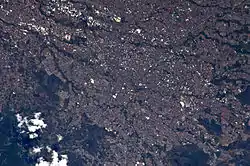La Sabana Metropolitan Park
La Sabana Metropolitan Park (Spanish: Parque Metropolitano La Sabana) is located in downtown San José, Costa Rica. It is the country's largest and most significant urban park.[1] La Sabana is considered "the lungs of San José" by Costa Ricans.[2]
| La Sabana Metropolitan Park | |
|---|---|
| Parque Metropolitano La Sabana | |
 Panorama of La Sabana Metropolitan Park, and San José locale | |
| Type | Urban park |
| Location | San José, Costa Rica |
| Coordinates | 9°56′08″N 84°06′15″W |
| Area | 619,409.92 square metres (153.05952 acres) |
| Created | 1977 |
| Status | Open all year |



Geography
Covering an area of 0.72 square kilometres (0.28 sq mi), La Sabana Metropolitan Park is adjacent to the city's core districts, offering green space and recreation to the residents of San José.
Several important institutions and organizations are located within or adjacent to the park.[3]
History
La Sabana Metropolitan Park was officially inaugurated in 1977, though its origins go back two centuries. Manuel Antonio Chapuí, the parish priest of San José at the end of the 17th century, donated several plots of land in the Mata Redonda District "in order to favour Costa Rica's interests". Since that time, the area has been used for recreation and sports activities.[3]
Costa Rica's first president, Juan Mora Fernández, and other josefino personalities devoted themselves to provide the park with several dispositions with the aim of preserving this green area legacy.[3]
For more than 150 years the park developed its characteristic vegetation, spurred by planting campaigns from the citizens. In 1930 this project was halted when the government decided to locate the country's first international airport within the park area. La Sabana International Airport functioned for 44 years, until the opening of the current Juan Santamaría International Airport.[4]
During the decade of the 1960s the idea of turning La Sabana into San José's lungs was taking up again. With that goal, trees, shrubs and grass were planted. In 1977, during the Daniel Oduber Administration, La Sabana was officially classified as a Metropolitan Park. In 2001 La Sabana was declared a National Architectural Heritage, by an Executive Decree.[3]
Landmarks
La Sabana Metropolitan Park's most prominent buildings are the country's national stadium and the Costa Rican Art Museum (Museo de Arte Costarricense). Both are sited within the park's green space. The stadium is located above the old stadium's former location.[5] The art museum is housed in the former main building of 'old' La Sabana Airport.[6]
A large artificial lake, several sports fields, running and skating tracks, a gymnasium, and a shooting range are also inside its boundaries. Surrounding the park, several institutions have their main offices. These include the main electricity company of Costa Rica, Instituto Costarricense de Electricidad, and the nation's Contraloría General de la República de Costa Rica (Comptroller General) headquarters.
References
- La Sabana Metro Park article Archived 2009-04-19 at the Wayback Machine. Instituto Costarricense del Deporte (ICODER) website.
- Josefino parks and plazas on celebrations. Al Día Newspaper website.
- La Sabana Metro Park History Archived 2011-07-18 at the Wayback Machine — Executive Decree 29305-C, dated February 23, 2001. Consejo Nacional de la Persona Adulta Mayor (CONAPAM) website.
- La Sabana Airport History Archived 2009-03-16 at the Wayback Machine. Costa Rican Art Museum website.
- New National Stadium Article. Informa-Tico, Digital Newspaper.
- La Sabana Airport History Archived 2009-03-16 at the Wayback Machine. Costa Rican Art Museum website.
